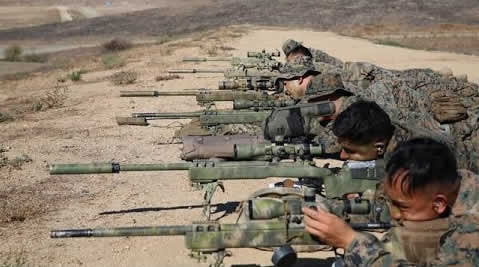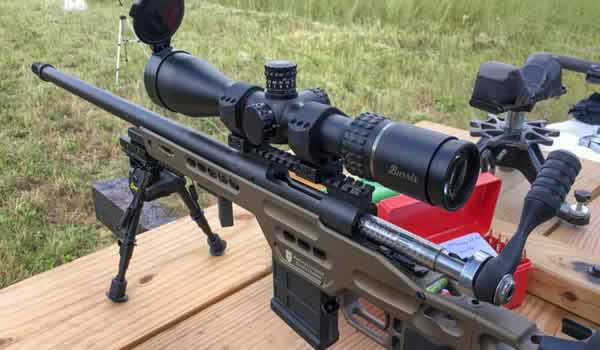
Are Snipers the Ultimate Cool Soldier?
In a segment from National Geographic Ultimate Soldiers we look at one of snipers attribute, that is “mind control“. A well-trained sniper uses mind over matter to control his own physiology. A situation that many snipers find themselves in the middle east is operating in a hot climate.
In this test to highlight a long range precision shooter ability to shoot between heartbeat. Researchers build a sniper coffin with a gun port, 100 feet away sits a target. Increasing the heat temperature is another simulation to increase the stress on the sniper. Increased heat can raise your heart rate and with longer period exposed can instill dehydration. See how cool this sniper does on this test.
Video Transcription
Doug: Ok, today we’re gonna be doing some Sniper testing, and we have secured the services of a United States Marine Corps Scout Sniper, who is still operational, and he’s gonna be wearing a balaclava, and for that reason, we’re going to introduce him only as Mike.
Narrator: Mike’s missions are so critical, we must obscure his identity for the test.
Mike: One quiet professional, at the right place, at the right time, can end wars before they start. One shot, one kill. Marine Scout Sniper.
Doug: Well what we’ve done here is, we’ve made a sniper coffin. We’ve got over here this plexiglass box, and we’re gonna put you in this box. It’s got a gunport right here, you’ll put your gun through the gunport, and you’ll be shooting at a target 100 feet away. Explain to me this ‘pulling a trigger off between heartbeats’ thing.
Mike: You can feel your heartbeat basically rebounding off the surface that you’re resting on.
Doug: And I guess you’re just timing the shot between the beats that you’re already feeling.
Mike: Yes.
Doug: Now you’ve operated over in the middle-east, right? So you’re used to the heat.
Mike: Correct.
Doug: Ok.
Narrator: To test the sharpshooter’s breaking point under the combat conditions of the Middle East, the Fight Science crew will raise the stakes, and the temperature.
David Sandler: Extreme heat does a lot to the body. Obvious things like dehydration are some of the first things that come to mind, and that of course increases heart rate, breathing rate–”
Doug: Pretty hot in there, David?
David: It’s up at 130 degrees. It’s right up there.
Narrator: Doug Martin assembles the safety team, and reviews the dangers of firing live rounds in the Lab.
Doug: Shooting guns indoors is not exactly a safe endeavour. Eyes and ears. Everybody needs to have eye protection on, if there is a safety violation or if there is an emergency where there’s an injury, I’ll call Ed in, the medic– alright, let’s have a safe shoot.
Narrator: The sniper wears a bio-harness to monitor his heart rate and breathing, so the scientists can measure his performance under extreme combat conditions. He will also be swallowing a pill that measures his core body temperature.
Mike: I was a little worried, swallowing a white pill before they throw me in a box called a Sniper Coffin.
Narrator: High-tech thermal imaging will project the sniper’s core body temperatures onto a monitor, so scientists can track his vitals. If his core temperature rises, so will his heart rate, leaving him less time to shoot between beats.
Doug: You know what’s interesting is, under all this stress your heart rate’s still nice and baseline, nice and mellow.
Narrator: The sniper’s been in the 130 degree heat chamber for 20 minutes. His core temperature has risen by one degree, but he’s not focusing on the heat, he’s focusing on his breathing.
Doug: Ok, this is a live shot!
David: Now we’re gonna see if we can distinguish truth from legend, and see if a sniper can actually shoot between heartbeats.
Doug: Three, two, one, fire.
[Shot]
Doug: Weapon on safe?
Mike: Yeah.
Doug: Whew! Ok, wanna see how you did?
Mike: Yeah.
Doug: Alright, can you run the high-speed please? Phew! Nice. Nicely done!
Narrator: The shot is dead-on. An easy distance for a sniper, but was it between heartbeats?
David: Well you actually did it, and our rhythm shows it smack between heartbeats, like you had it perfectly timed.
Mike: I was able to keep my heart rate under control by relaxing, diaphragmatic breathing, clearing your mind, thinking about nothing but what’s right around you.
Narrator: So how did Mike shoot between heartbeats? In the 130-degree coffin, Mike’s heart beats 135 times per minute. With each beat, a surge of blood fills the vessels. As the blood reaches the trigger finger, it swells with each pulse. This pulse is enough movement to cause a slight deviation in the sniper’s shot, making the difference between a direct hit, or a missed target. To pull off an accurate shot, Mike must slow down his heart rate. First he decreases his respiratory rate, by taking extended full-diaphragmatic breaths. He gradually reduces his breathing from eighteen breaths per minute to approximately six. within a few minutes, he lowers his heart rate to eighty-four beats per minute. This creates more time to shoot between heartbeats. Timing is everything. Immediately after Mike feels his heartbeat reverberate off the surface he’s resting on, he pulls the trigger. Shooting his weapon between beats, and hitting his target dead-on.
Sources: National Geographic Youtube



